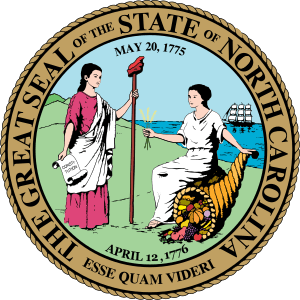Elias Carr
Elias Carr (February 25, 1839 – July 22, 1900) was the 48th Governor of the U.S. state of North Carolina from 1893 to 1897. He was born in Edgecombe County, North Carolina. A building on the campus of UNC-Chapel Hill is named after him.
Elias Carr | |
|---|---|
 | |
| 48th Governor of North Carolina | |
| In office January 18, 1893 – January 12, 1897 | |
| Lieutenant | Rufus A. Doughton |
| Preceded by | Thomas Michael Holt |
| Succeeded by | Daniel Lindsay Russell |
| Personal details | |
| Born | Elias Carr February 25, 1839 Edgecombe County, North Carolina |
| Died | July 22, 1900 (aged 61) Edgecombe County, North Carolina |
| Political party | Democratic |
| Spouse(s) | Eleanor Kearney |
| Children | 6 |
| Alma mater | University of North Carolina at Chapel Hill |
| Profession | Lawyer, politician, farmer |
He graduated from the University of North Carolina at Chapel Hill (1855–1859) and also attained a law degree from the University of Virginia and then returned to the 100-year-old family plantation, Bracebridge Hall. He married Eleanor Kearney, the youngest daughter of William Kinchen Kearney and Benjamin Hardee James Marie Alston Kearney, in 1860 and was the father of six children: Dr. William Kearney Carr, John Buxton Carr, Mary Elizabeth Carr, Elias Carr, Eleanor Kearney Carr, and Annie Bruce Carr. Carr was a member of the board of directors of Rocky Mount Mills, trustee of N.C. College of Agriculture and Mechanical Arts (today known as North Carolina State University), commissioner of the N.C. Geological Survey, agriculturist, and businessman.
Carr became prominent as head of the state Farmers Alliance and Industrial Union (1889–1892). He was part of a more moderate or conservative faction of the Alliance that opposed splitting from Democrats to form a third party. In 1892, he defeated incumbent Gov. Thomas Michael Holt for the Democratic gubernatorial nomination.[1] Carr then won the three-way race over the Republican candidate, Judge David M. Furches, and the Populist candidate, Dr. Wyatt P. Exum. Carr did not win an absolute majority of the vote, perhaps foreshadowing the 1894 election, in which Democrats lost control of the legislature to an electoral fusion of Populists and Republicans, and the 1896 election, in which Democrats lost the governor's race for the first time since 1872. During his term in office, Carr promoted better school facilities and regulation of railroads. After his governorship, he returned to Bracebridge Hall where he died of a 'thyroid condition' in July 1900. He is buried in the Carr Cemetery at Bracebridge Hall.[2]
References
- History of North Carolina: North Carolina since 1860, pp. 235 and 237.
- Davyd Foard Hood (December 2004). "Bracebridge Hall" (pdf). National Register of Historic Places - Nomination and Inventory. North Carolina State Historic Preservation Office. Retrieved 2014-11-01.
| Party political offices | ||
|---|---|---|
| Preceded by Daniel Gould Fowle |
Democratic nominee for Governor of North Carolina 1892 |
Succeeded by Cyrus B. Watson |
| Political offices | ||
| Preceded by Thomas Michael Holt |
Governor of North Carolina 1893-1897 |
Succeeded by Daniel Lindsay Russell |
